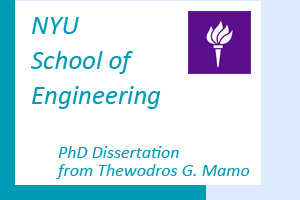
Virtual District Meter Area Municipal Water Supply Pipeline Leak Detection and Classification Using Advance Pattern Recognizer Multi-Class Support Vector Machine for Risk-Based Asset Management
Author: Thewodros G. Mamo
Abstract:
Municipal water supply network systems are composed of a wide range of complex buried infrastructure. Many of these essential infrastructures have reached or exceeded their design life cycle and needs sound rehabilitation and replacement (R&R) Maintenance Strategies. However, maintaining and repairing such an ageing and complex water supply pipeline network systems in metropolitan cities presents unique decision and management challenges for water utility companies with 5 respect to how to detect, monitor, carry out the ranking and evaluation process and decide which of these complex wide ranges of buried infrastructure from the networks required replacement or rehabilitation in a cost-effective manner.
In the context of water losses, municipal water supply pipeline leakages are one of serious problems for many metropolitan cities, and remain a tremendous challenge for many of water utility companies. The economic and property damage costs associated with pipeline leakages or breaks are rapidly rising in an alarming rate and become the main causes for loss of revenue. Undetected leakage could continually increase the amount of water loss without being invoiced or metered. Water losses deprive public water utility companies from additional revenue, and paralyzed their effort to expand services. The overall impairment caused by leakage or breaks depend on the time between the actual leak detected and its isolation. For many of metropolitan cities water utility companies these tasks are complicated due to lack of active or limited leakage detection & monitoring system, which makes the presences of leakages are identified when it became visible on the surface, or reported by the public, during this time the consequences can be both expensive and harmful. Therefore, to avoid such catastrophic consequences, today most water utility companies and municipalities have established state of the art best practice method to divide the entire water supply networks into smaller monolithic forms, which can be more manageable zones, called district meter area.
6 The district meter area method associated with cutting edge technologies enable water utility companies to utilize different multi parameter sensors and monitoring systems in the pipeline networks that allow data to be collected based on the utility company needs and utilized, analyze and simulate the pipeline networks operational system for preemptive solution and monitoring almost near real-time. The concept of district meter area leak and pressure management methods have also limitation and disadvantages. Therefore, the challenges of loss of revenue due to water loss, and the drawback of the existing methodologies implemented to detect and monitor water leakages or breaks keep the water utility companies actively searching for innovative approaches for early leak or break detection and classification methodologies, which can also be used for decision support based on analysis of options, that involves evaluation of many criteria and parameters that maximizes the optimal maintenance strategies and prioritization for rehabilitation and replacement of water supply infrastructures.
In this research we investigated and analyzed the concept of virtual district meter area as the core objective of the research to resolve the current gap and limitations of the district meter area state of practice through the development of virtual district meter area leakage monitoring and classification system using multi-class support vector machine advanced pattern recognizer at Lille University water distribution systems study area the so called “Zone Six”. The support vector 7 machines were trained on multiple cases which represent the presence of leak in different sizes and locations. The research results, and analysis showed a rather promising performance, which could be successfully implemented for leak detection and classification. The proposed method could enable the water utility companies and other stakeholders to further reduce risks associated with pipeline leakage or breakage. This method can be used during decision-making process for selecting which water distribution system infrastructure required urgent action, and engineer the optimal short-term response or alternative rehabilitation and replacement (R&R) Maintenance Strategies. Furthermore, the proposed methodology could benefit the water utility companies by reducing the cost and operational drawbacks associated with implementing physical district meter area. It also improve the day to day operational decision making process by detecting and classifying the different stages of pipelines leakages and breakages according to their severity, which can help the operators to see the behavior of the network on the control room screens they are familiar with and enable them to quickly perform the best short-term response strategy.

